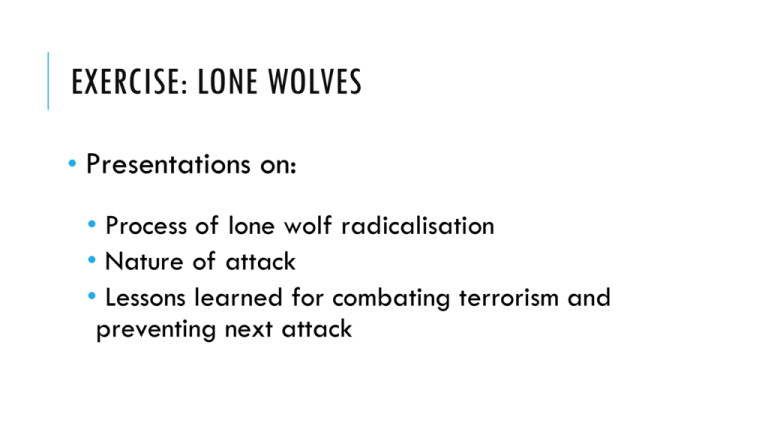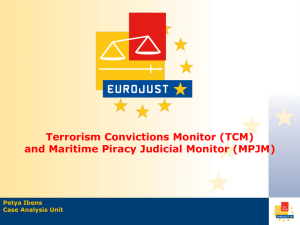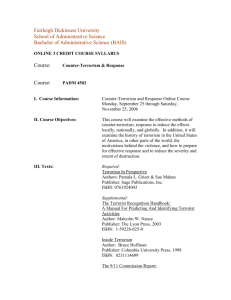IWOF Lecture 4 – Religious Terrorism
advertisement

EXERCISE: LONE WOLVES • Presentations on: • Process of lone wolf radicalisation • Nature of attack • Lessons learned for combating terrorism and preventing next attack RELIGIOUS TERRORISM IWOF LECTURE 4 DR FRANK O’DONNELL STRUCTURE OF PRESENTATION • Unique characteristics of religious terrorism as compared to other forms • Common characteristics of religious terrorist groups • How religious terrorist groups end LEARNING OUTCOMES • Understand factors driving recent popularity of religious terrorism • Evaluate difficulties posed by religious terrorist psychology for combating religious terrorism • Assess factors explaining successful efforts to combat religious terrorism WAVES OF MODERN TERRORISM 1. Anarchist wave – 1880s to 1920s 2. Anti-colonial wave – 1920s-1960s 3. New Left wave – 1960s-1979 4. Religious wave – 1979-present • Frustrations with previous secular leftist, Marxist ideologies David Rapoport, “Generations and Waves: The Key to Understanding Rebel Terror Movements,” UCLA, 2003, available at http://international.ucla.edu/media/files/David_Rapoport_Waves_of_Terrorism.pdf MODERN RELIGIOUS TERRORISM: THE FOURTH WAVE 1. Anarchist wave – 1880s to 1920s 2. Anti-colonial wave – 1920s-1960s 3. New Left wave – 1960s-1979 4. Religious wave – 1979-present DIFFERENCES WITH OTHER FORMS OF TERRORISM Symbolic tactic: suicide bomber General tactics and scale of violence Motivations Bringing religious terrorists to the negotiating table RELIGIOUS TERRORISM IS NOT SOLELY ISLAMIC TERRORISM New America Foundation study. Data available at: http://securitydata.newamerica.net/extremists/deadlyattacks.html COMMON CHARACTERISTICS OF RELIGIOUS TERRORIST GROUPS: PSYCHOLOGY 1. Motivating sense of humiliation 2. Demonisation of enemies • “The conflict is between God's will and kingdom and Satan's opposing will and kingdom” – Rev. Paul Hill, US right-wing terrorist 3. Goal of union with God • Purifying world through extermination of impure people • 9/11 Atta letter: perpetrators “heading toward eternal paradise” 4. Sanctification of violence • Graffiti in Gaza: “Death in the way of Allah is life” James W. Jones, “Sacred Terror: The Psychology of Contemporary Religious Terrorism”, in Andrew Murphy (ed.), The Blackwell Companion to Religion and Violence (Blackwell, 2011) COMMON CHARACTERISTICS OF RELIGIOUS TERRORIST GROUPS: TACTICS 1. Often indiscriminate targeting 1. Covenant, Sword and Arm of the Lord Christian fundamentalist group plots to poison city water supplies – 1980s 2. Jewish Underground group plots to bomb Muslim holy sites on Temple Mount – 1984 2. Propensity to use WMD 3. Disinterest in proportionality 4. Spiralling scale of violence 1. Media saturation compelling greater scale of attack in order to shock 2. Demonisation dynamic means little inhibitions against ever-greater attacks HOW RELIGIOUS TERRORIST GROUPS END 1. Important to distinguish between group long-term aims and near-term means • Svensson and Harding (2011) study Asian religious terrorist groups from 1989-2008: more than half reached some political accommodation with government through focus on changing near-term means 2. Groups can disintegrate due to mundane causes • Al-Qaeda in Iraq: o o o o Overpromising and underdelivering services Bureaucratic infighting Wasteful financial management Vulnerable communications and logistics Also: Isak Svensson and Emily Harding, “How Holy Wars End: Exploring the Termination Patterns of Conflicts With Religious Dimensions in Asia”, Journal of Terrorism and Political Violence Vol. 23 Issue 2 (2011) LEARNING OUTCOMES • Understand factors driving recent popularity of religious terrorism • Evaluate difficulties posed by religious terrorist psychology for combating religious terrorism • Assess factors explaining successful efforts to combat religious terrorism




